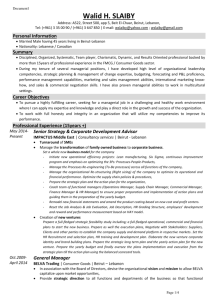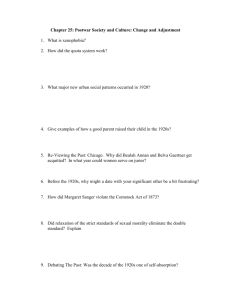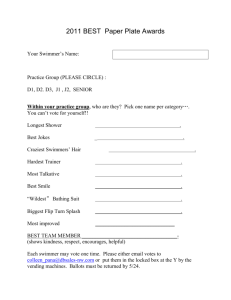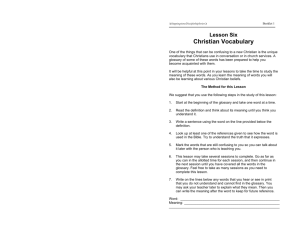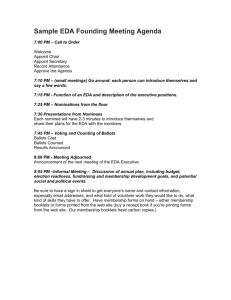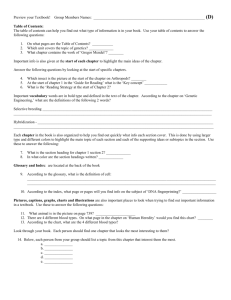Ballots for Belva - Sudipta Bardhan
advertisement
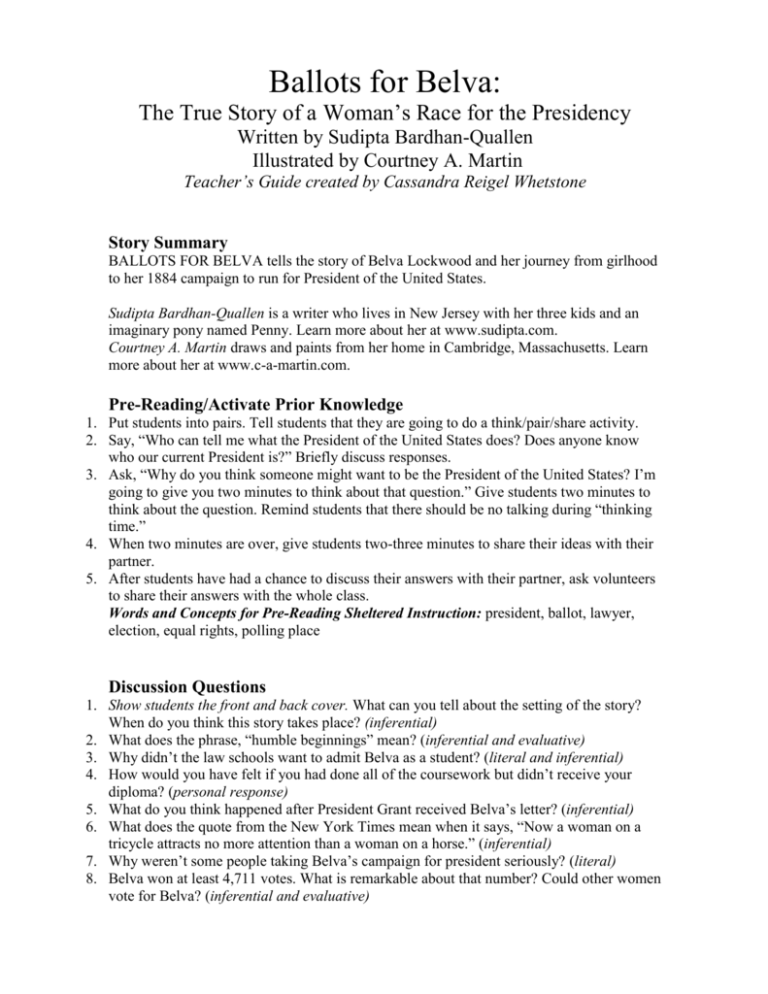
Ballots for Belva: The True Story of a Woman’s Race for the Presidency Written by Sudipta Bardhan-Quallen Illustrated by Courtney A. Martin Teacher’s Guide created by Cassandra Reigel Whetstone Story Summary BALLOTS FOR BELVA tells the story of Belva Lockwood and her journey from girlhood to her 1884 campaign to run for President of the United States. Sudipta Bardhan-Quallen is a writer who lives in New Jersey with her three kids and an imaginary pony named Penny. Learn more about her at www.sudipta.com. Courtney A. Martin draws and paints from her home in Cambridge, Massachusetts. Learn more about her at www.c-a-martin.com. Pre-Reading/Activate Prior Knowledge 1. Put students into pairs. Tell students that they are going to do a think/pair/share activity. 2. Say, “Who can tell me what the President of the United States does? Does anyone know who our current President is?” Briefly discuss responses. 3. Ask, “Why do you think someone might want to be the President of the United States? I’m going to give you two minutes to think about that question.” Give students two minutes to think about the question. Remind students that there should be no talking during “thinking time.” 4. When two minutes are over, give students two-three minutes to share their ideas with their partner. 5. After students have had a chance to discuss their answers with their partner, ask volunteers to share their answers with the whole class. Words and Concepts for Pre-Reading Sheltered Instruction: president, ballot, lawyer, election, equal rights, polling place Discussion Questions 1. Show students the front and back cover. What can you tell about the setting of the story? When do you think this story takes place? (inferential) 2. What does the phrase, “humble beginnings” mean? (inferential and evaluative) 3. Why didn’t the law schools want to admit Belva as a student? (literal and inferential) 4. How would you have felt if you had done all of the coursework but didn’t receive your diploma? (personal response) 5. What do you think happened after President Grant received Belva’s letter? (inferential) 6. What does the quote from the New York Times mean when it says, “Now a woman on a tricycle attracts no more attention than a woman on a horse.” (inferential) 7. Why weren’t some people taking Belva’s campaign for president seriously? (literal) 8. Belva won at least 4,711 votes. What is remarkable about that number? Could other women vote for Belva? (inferential and evaluative) 9. Show students the last page of the story. Why do you think the illustrator painted the picture of the girl handing Belva flowers? What do you think the girl might be thinking? (analytical and personal response) 10. Let’s look back at the first part of the story. It says, “...with a little bit of faith, anyone can move a mountain.” What do you think that means? (evaluative and personal response) 11. What do you think the author might want you to learn from this story? (analytic) Response to Story: “If I Were President” (Writing, Public Speaking) 1. 2. 3. 1. 2. 3. 4. Grades K-6 Materials: white construction paper; crayons or markers; pencils; writing paper, (for grades 2-6); index cards, (optional for grades 2-6) Preparation: None Session One Tell students that when someone runs for president, they have to run a campaign. Ask, “Can anyone tell me what does the word campaign mean?” Discuss campaigns and note that they include advertisements and speeches. Do a picture walk through BALLOTS FOR BELVA and point out campaign signs and slogans. Say, “We are going to pretend that you are running for President. If you were going to make a poster advertising that you were running for president, what words would you need to know?” Brainstorm words such as, vote, President, ballot, and record on the board. Give each student a piece of paper and markers or crayons. Have each student make a campaign poster using his or her own name. Collect posters. Session Two Tell students that one of the ways people campaign is to give speeches about what they would do as president. Show students pages 20-21 in BALLOTS FOR BELVA and re-read the first paragraph. Say, “If you were President, what would you do?” Brainstorm ideas and record key words on the board. Pass out campaign posters from the previous session. Write on the board, “If I were president, I would ____________________.” Grade K-1: Have students write and complete the sentence on the back of their posters. Grade 2-4: Have students write a paragraph using the cloze sentence as a topic sentence. When finished, consider having students rewrite paragraph on an index card. Grades 5-6: Have students write 3-5 paragraphs using the cloze sentence as an opening line. When finished, consider having students rewrite paragraphs on index cards. Allow time for students to practice reading their speeches to partners or table groups. Remind students to speak clearly, slowly, and to project their voices. Closure: Have students stand in front of the class, show their campaign posters and read their campaign speeches. Women’s Suffrage in the United States Timeline (History) Grades 3-6 Materials: Copy of Women’s Suffrage timeline from BALLOTS FOR BELVA; 8.5in. x 11in. sheets of white or drawing paper, one per student; crayons or markers Preparation: Divide the number of events by the number of students so that each student would get one-two events. Cut the copy of the timeline into one-events per student. Directions: 1. Say, “Does anyone know what a timeline is?” Explain to students that a timeline is a sequence of events over time. Show students the Women’s Suffrage timeline and explain that “Suffrage” means “the right to vote.” 2. Tell students that this particular timeline has two parts. The events in black show the timeline for women’s suffrage, and the events in red make show the timeline for Bella Lockwood’s life. Read the timeline to the students. 3. Tell students that they are going to make an illustrated version of this timeline. Pass out event(s) and a piece of paper to each student. Have students write the date of their event on the top of their page. Tell them to write the description of their event on the paper and then illustrate it. 4. When the students are finished, help them line-up in order, according to the dates of their events. Allow students to take turns reading their events and sharing their pictures. Extension: If students have access to the internet, let them research other events, discoveries, or famous people from the year of their event. Encourage students to add more illustrations and/or write descriptions to show what else was going on in the world at that time. Transportation: Then and Now (Venn Diagrams) 1. 2. 3. 4. 5. Grades K-3 Materials: Chalkboard, white board, or chart paper; one copy of “Transportation: Then and Now” Venn Diagram per student Preparation: Write the words “Then” and “Now” on the board. Directions: Do a picture walk through BALLOTS FOR BELVA and identify the different types of transportation that people used in the story. List the types of transportation under the word, “Then,” e.g. walking, tricycle, horse and buggy, wagon. Brainstorm types of transportation that we have today. List today’s transportation under “Now,” e.g. walking, cars, bicycles, airplanes, subways, etc. Note words that are on both lists. Pass out copies of “Then and Now” Venn diagrams and help students write the different types of transportation in “Then,” “Now,” or “Both.” Help students answer the summary statements about the diagram. Name________________________________ BALLOTS FOR BELVA TRANSPORTATION: THEN AND NOW NOW THEN BOTH 1. There are _________________ different types of transportation on my chart. 2. ____________ has the most types of transportation and ____________ has the fewest types of transportation. 3. If I lived then, my favorite type of transportation would be________________ because ________________________________________________________. Belva Lockwood vs. Victoria Woodhull (Graphing, Fractions) 1. 2. 3. 4. Grades 2-6 Materials: Three sheets of chart paper; markers; small pieces of paper, one per student; writing paper Preparation: Prepare a tally sheet. Draw three rows on the chart paper. Label the first row “Belva Lockwood,” the second, “Victoria Woodhull,” and the third, “Undecided.” Prepare a bar graph. Draw three bars near the bottom of the second sheet of chart paper. Write “Belva Lockwood”, “Victoria Woodhull”, and “Undecided” under the bars. Prepare a pie chart. Draw a large circle on the third chart. With a light pencil, roughly divide the pie chart into segments that equal the number of students. Write this key on the side of the circle: = Belva Lockwood = Victoria Woodhull = Undecided Display charts on board or wall. Directions: 1. Read the Author’s Note at the end of BALLOTS FOR BELVA. 2. Briefly discuss the question, “Who do you consider to be the first woman to run for President.” 3. Tell students that they are going to vote on who they consider to be the first woman president. Pass out the slips of paper and tell students that the paper is their ballot. Tell them that they may each vote for either Belva, Victoria, or if they can’t decide, they may vote for “Undecided.” 4. Collect ballots. 5. Read votes out-loud and record on the tally sheet. 6. Tell students that there are several ways to organize the final vote count. Ask, “How could we use the bar graph to display the vote?” Have students help fill in the bar graph. 7. Ask, “How could we use the pie graph to display the vote?” Have students suggest a color key. Select different color for Belva, Victoria, and Undecided. Draw a sample of each color to the left side of the equal signs in the key. 8. Identify the fractions that represent each group of votes. Let students help color in the pie chart. Closure: Have students answer the following questions on a piece of writing paper, (or in their math journals.) Remind students to write their answers in complete sentences. 1. Who had the most votes and who had the least votes? 2. Were you surprised by the results? Why or why not? 3. Which graph do you think was the best way to organize the votes? Why? Extension: Have students select their own topic and survey 10-12 classmates, family members, and friends to “vote” on an answer. Have students create a graph to display their results. Ballots for Belva’s Glossary Match-Up (Vocabulary) 1. 2. 3. 4. 5. 1. 2. 3. 4. 5. 6. 7. Grades 3-6 Materials: 1-2 copies of the glossary at the end of BALLOTS FOR BELVA; 8in. x 2in. strips of tag board or other sturdy paper; scissors, tape or glue stick; marker; bag, basket or hat Preparation: Select one glossary term and definition per two students in class. If there are 18 students, use each word once. If there are 30 students, select six words to use twice and use the remaining three words once. Cut out glossary definitions. Separate terms from definitions by either cutting them out or darkening them with a black marker. Use tape or glue to affix the definitions to separate strips of tag board. Write each glossary term on separate strips of tag board. Put all of the strips together in a bag. There should be one strip per student. (If there is an odd number of students two students can share a strip or the teacher can participate in the match-up.) Note: Be sure the number of strips in the bag matches the number of students in attendance during the activity. Directions: Tell students to listen carefully while you read through the glossary. Tell them you are only going to read it one time. Read the glossary and answer any questions the students may have about the terms. Say, “We are going to play a vocabulary match-up game. Each of you will draw a strip of paper that has either a glossary term or a definition. If you draw a glossary term, go to the left side of the classroom. If you draw a definition, go to the right side of the classroom.” Move through the students allowing them to draw a strip. Tell them to read it privately and then move to appropriate side of the room. When all students have a strip, tell them that they need to match-up with their counterpart. Tell them they will have to read their strips to each other until they find their match. When they think they’ve found a match, have them sit down next to each other. Remind students that there can only be two people in a pair. While students are finding their pairs, help students read the definitions. Don’t give students the correct answer but help them decode words and identify the meaning of words in the definitions as needed. When all of the students are sitting in pairs*, have everyone stand up. Have pairs read their glossary term and definition out loud. If they are correct, have them sit back down. If they are incorrect, direct them to move back to the left and right sides of the room. When the pairs have all shared out, help any students who are unmatched find their correct partner. *Note: If most of the students are sitting in pairs and the remaining students cannot find match-ups that they think are correct, have the unmatched students return to either the left or the right side of the room and continue with step 6. Extension: Definitions and glossary terms can be stored in an envelope to be used as a matching/memory or “Go Fish” game. Interview Belva and Other Characters (Perspective, Dramatic Improvisation) 1. 2. 3. 4. 5. 6. 7. 8. Grades K-6 Materials: index cards or pieces of paper; pencil or pen; bag, basket or hat Preparation: None Directions: Reread or do a picture walk through BALLOTS FOR BELVA. Identify important characters in the book and write down their names on the board. Characters may include Belva, President Ulysses S. Grant, Marietta Snow, Grover Cleveland, Abigail Duniway, and even the cat. Brainstorm questions you might ask any of the characters if they were to walk into the classroom today. Write the names of the characters on individual index cards and put into a bag. Write the word PERSPECTIVE on the board. Explain to students that perspective is the position from which something is looked at, thought about, or evaluated. Say, “We are going to play an interview game and volunteers are going to answer questions from the perspective of the different characters. If you would like to pretend to be a character, please raise your hand. If I call on you, you may draw a name out of the bag and read the name out loud.” Remind students that for the purposes of this activity, it doesn’t matter if the student is a boy or girl for any character. Have a student draw a name out of the bag and direct him or her to stand or sit in front of the room. Say, “Now we are going to interview you, and I’d like you to answer from the perspective of the character.” Remind students that although the characters are based on real people, the answers are going to be fictional and they don’t need to worry about whether or not they are true. Have students raise their hands and ask questions. Help the volunteers consider how to answer the questions from the perspective of their character. Repeat steps 5 and 6 until all of the characters have been interviewed. Modification for K-1: Teachers of younger students may need to play the role of the characters while the students ask questions. Sample Interview Questions For Belva When you were a little girl, did you dream about being president? Did you think you might really win? What would you have done if you were the President of the United States? For President Ulysses Grant How did you feel when you got Belva’s letter? Do you think a woman could be president? For Marietta Snow What did your family say when you told them that you were running for Vice President? What was your favorite part of the campaign? Ballots for Belva Write an ACROSTIC poem about Belva! B____________________________________________ E____________________________________________ L____________________________________________ V____________________________________________ A____________________________________________ Ballots for Belva Crossword 1 2 3 4 5 6 7 8 9 10 11 Down 1. Belva's home state (2 words) Across 3. How many times was Belva married? 2. When Belva ran for President, women could not ______. 4. Belva believed that, if you try hard enough, you can move _________________. 7. Belva rode on this to get around Washington, DC 5. To become President, a candidate must receive the most ___________ votes. 6. The President who signed Belva's diploma 8. Belva's Republican opponent 9. Belva's Democratic opponent 10 Belva's middle name . 11 Belva's daughter .
